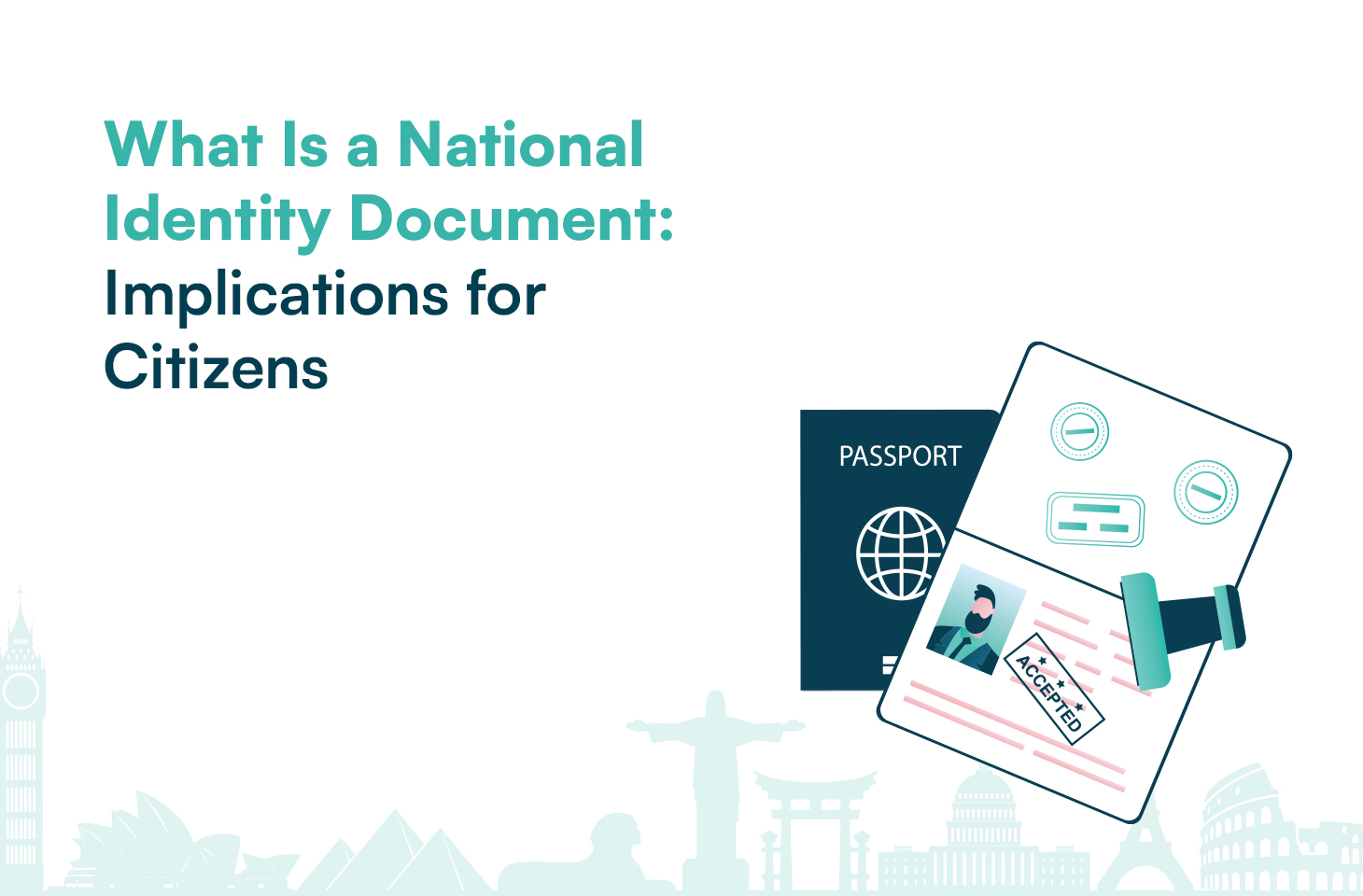In today’s complex regulatory environment, ensuring proper identification during customer onboarding is paramount. National identity documents play an essential role in the know your customer (KYC) process, serving as a cornerstone for reliable identity verification and risk management. These documents are not only issued by governmental authorities but also hold legal significance for financial institutions, regulatory authorities, and businesses that require due diligence for AML (anti-money laundering) screening. The integration of nationally recognised identity documents within automated onboarding systems and digital identity verification platforms has helped streamline compliance processes and reduce corruption risks. Furthermore, the advancement of technologies such as biometrics, optical character recognition (OCR), and blockchain-based identity management has elevated the accuracy and security of KYC procedures. In this article, you will learn what constitutes a national identity document, understand KYC fundamentals and their regulatory frameworks, explore how these documents facilitate customer identification, and review the security challenges and evolving technological landscape in compliance. Let’s journey through these insights to build a strong foundation for managing risk, fraud prevention, and regulatory compliance in your institution.
Defining What Constitutes a National Identity Document for Verification
National identity documents are official documents issued by government authorities to certify an individual’s identity and citizenship. In the context of KYC compliance, these documents are pivotal in validating personal information and ensuring that a customer is who they claim to be. They are generally characterised by security features such as holograms, watermarks, and embedded microchips that enhance their resistance to forgery and counterfeiting.
Core Characteristics of Official Identification Papers
The core characteristics include a standardised format, official seals, unique identification numbers, and biometric data when available. These features ensure the document’s integrity and authenticity. For example, many national IDs come with computerised sorting mechanisms to assist government databases during verification processes. An improvement in the use of such features can reduce the instances of identity theft and fraud. Additionally, these documents include personal details like name, date of birth, address, and sometimes even fingerprints or iris scans. This comprehensive dataset supports secure identity verification and ensures robust law enforcement and regulatory compliance.

Distinguishing National IDs From Other Forms of Identification
National IDs differ from passports, driver’s licenses, or social security cards because they are issued solely for the purpose of establishing legal identity. While passports are used primarily for international travel, national IDs are utilised day-to-day to validate identity in various internal processes, including banking transactions and public service use. This distinction ensures that KYC processes, which rely on real-time and easily verifiable data, are not compromised by outdated or secondary documents. With advancements such as digital notaries and machine learning algorithms, the use of national ID data has further evolved to become an integral part of continuous monitoring and risk management in today’s financial industry.
The Governmental Issuance and Recognition of National IDs
Governmental issuance of national identity documents follows stringent legal guidelines and international standards. These documents are recognised both locally and, in some cases, internationally due to their adherence to specifications set by bodies like the International Civil Aviation Organisation (ICAO) for machine-readable travel documents. Recognition of these IDs is essential for establishing trust between customers and institutions. Besides, the digital transformation of these documents has enabled agencies to instantly cross-reference identities through centralised databases, thereby reducing discrepancies and improving overall efficiency. Integration of such systems with onboarding solutions reduces manual processing errors while addressing compliance complexities such as those associated with the Patriot Act, Bank Secrecy Act, and AML regulations.
Examples of National Identity Documents Across Different Regions
Examples include the Aadhaar card in India, the National Identity Card in various European nations, the My Number card in Japan, and the DNI in Spain. Each of these documents incorporates unique security features tailored to local regulatory requirements. For instance, the Indian Aadhaar card utilises biometric authentication, including fingerprint and iris scans, which significantly enhances identity verification reliability. In contrast, many European nations rely on multi-factor data that integrates both physical and electronic features. These variations underline why institutions must understand different national identity standards when performing cross-border KYC due diligence.
The Purpose of a National Identity Document in Civic Life
The primary purpose of national identity documents is to establish a person’s legal presence and facilitate their engagement in civic, economic, and social activities. They serve an essential role in accessing various services from banking to healthcare. In the realm of regulatory compliance, they are indispensable for verifying the identity of customers to prevent fraud, terrorism financing, and corruption. The solid link between national IDs and governmental oversight also ensures that citizens can exercise their rights, such as voting and accessing public resources. By enhancing transparency, these documents not only support individual rights but also contribute to robust risk management in both public and private sectors, ultimately strengthening the overall integrity of businesses and financial institutions worldwide.
Grasping Know Your Customer KYC Fundamentals
Know Your Customer (KYC) is a critical process designed to ensure the integrity of financial institutions and prevent illegal activities such as money laundering, fraud, and bribery. KYC procedures require institutions to gather detailed personal information from customers and verify it through reliable sources such as national identity documents. This diligence is especially important in an era of digital transformation, where automated systems and machine learning algorithms play a significant role in risk assessment and customer onboarding. KYC is not simply a regulatory checkbox; it is an essential element in maintaining a transparent and ethical business environment that reinforces trust among customers and regulators alike.
The Objectives Behind KYC Procedures
The primary objectives behind KYC procedures include establishing the customer’s identity, assessing risk, and ensuring that the funds they bring into the financial institution are not derived from illicit activities. KYC practices are tailored to prevent money laundering and terrorism financing by demanding that customers provide verifiable proof of identity, such as government-issued identity documents. As a result, processes like enhanced due diligence (EDD) and customer due diligence (CDD) are implemented to evaluate risk factors such as politically exposed persons (PEPs) or clients in high-risk jurisdictions. With the growth of digital banking and cryptocurrency platforms, adherence to KYC protocols has become vital in safeguarding assets and ensuring compliance with international standards set by the Financial Action Task Force (FATF).
Regulatory Frameworks Mandating KYC Adherence
Regulatory frameworks across the globe mandate thorough KYC procedures. In the United States, acts like the Patriot Act and the Bank Secrecy Act enforce stringent measures. Similarly, Europe’s Fourth and Fifth Anti-Money Laundering Directives require institutions to employ rigorous KYC systems integrated with digital identity checks. Financial industry regulatory authorities in many countries have implemented guidelines that determine what constitutes acceptable verification documentation, such as national identity cards, passports, and uIDs. Non-compliance can not only lead to hefty fines but also jeopardise the institution’s reputation and ability to operate across borders. Regulatory compliance in this aspect is increasingly automated by utilising APIs, machine learning, and advanced data analytics to facilitate real-time customer verification and risk management.
Industries Most Impacted by KYC Requirements
While banks and financial institutions are the most obvious stakeholders, KYC requirements extend to various industries, including fintech companies, money transfer services, cryptocurrency exchanges, and even certain e-commerce platforms. These industries face high scrutiny due to the potential for fraud, money laundering, and other types of financial crimes. In addition, sectors such as wealth management and insurance also rely heavily on KYC to verify customer identity and monitor beneficial ownership. The integration of KYC procedures in these industries not only ensures compliance with federal financial institutions examination council guidelines but also enhances overall customer experience by reducing the risk of identity theft and fraudulent transactions.
Consequences of Non-Compliance With KYC Mandates
Failure to adhere to KYC mandates can have widespread consequences for institutions, including legal penalties, significant fines, and the potential loss of business licenses. Non-compliant entities may also face reputational risks, making future customer acquisition and business partnerships more challenging. In some cases, a lack of proper KYC measures can lead to severe operational disruptions, as financial institutions may be subjected to increased regulatory scrutiny and audits. Moreover, evidence indicates that robust KYC processes directly correlate to reduced incidents of fraud, theft, and money laundering, serving as a protective barrier for both institutions and the broader financial ecosystem.
The Customer Identification Program CIP Within KYC
The Customer Identification Program (CIP) is a fundamental component of KYC procedures designed to establish and verify a customer’s identity through reliable documentation. CIP requires institutions to collect and examine identity documents and supporting data to create a verifiable customer profile. This process is crucial for confirming that the identity information provided aligns with governmental records and complies with regulatory standards. CIP not only supports the integrity of the onboarding procedure but also enables institutions to conduct continuous monitoring and risk assessment, leveraging automated systems to detect discrepancies and prevent fraudulent activities. Enhanced integration of CIP with digital identity verification and biometric authentication further streamlines customer onboarding and mitigates risks associated with identity theft and corruption.
How National Identity Documents Facilitate KYC Processes
National identity documents significantly contribute to the efficiency and reliability of KYC processes by providing standardised, government-issued validation of individual identity. Integrating these documents into customer onboarding workflows ensures accuracy in identity verification, minimises fraud, and supports anti-money laundering (AML) efforts across various industries. The reliance on physical or digital national IDs allows financial institutions and fintech companies to quickly authenticate personal data, thus improving the speed and reliability of customer due diligence (CDD) efforts. Moreover, when used intelligently in combination with biometric data, national IDs substantially reduce the risk of identity theft and corruption within customer onboarding processes.
Verifying Identity Using National ID Information
The use of national identity documents in verifying customer identity is central to KYC practices. When customers present government-issued IDs—be it a national identity card, passport, or driver’s license—the information contained in these documents is cross-referenced with internal and external databases. This ensures that the identity details match and that any red flags are immediately raised. Advancements in digital identity verification, optical character recognition (OCR), and artificial intelligence (AI) algorithms enhance this process by rapidly verifying the authenticity of the document’s embedded security features. As a result, institutions can not only reduce onboarding friction but also ensure higher accuracy in customer identification while preventing fraudulent activities.
The Function of National IDs in Anti-Money Laundering AML Efforts
National IDs are instrumental in AML efforts because they function as a first line of defence against money laundering and financial terrorism. By leveraging comprehensive identification data from national documents, institutions can perform reliable screening against watchlists and known high-risk profiles. For instance, integrating national ID data with databases maintained by regulatory bodies such as the Financial Crimes Enforcement Network (FinCEN) or the Federal Financial Institutions Examination Council provides an immediate alert mechanism if discrepancies are identified. This tight integration between digital identity verification, machine learning-powered risk assessment, and national ID documents creates a robust ecosystem for minimising fraudulent transactions and ensuring compliance with global AML regulations.
Using National Documents for Customer Due Diligence CDD
Customer Due Diligence (CDD) processes benefit significantly from the use of national identity documents by establishing the authenticity and accuracy of customer data. CDD requires the collection, verification, and ongoing monitoring of customer information to assess risks and detect suspicious behaviour. National IDs offer standardised verification that reduces ambiguity and increases the reliability of the collected data. When combined with automated analytics, financial institutions can promptly generate risk profiles based on consistent national ID parameters. This not only enhances operational efficiency but also creates a foundation for continuous improvement in risk management systems tailored to prevent identity fraud and financial crimes, thereby meeting both national and international compliance standards.
National IDs as a Component of Enhanced Due Diligence EDD
Enhanced Due Diligence (EDD) becomes critical, especially when dealing with high-risk customers or politically exposed persons (PEPs). Incorporating national identity documents into the EDD framework ensures that institutions have access to reliable, government-validated identity data. This facilitates deeper scrutiny of customer profiles and assists in tracking beneficial ownership. Advanced techniques, such as biometrics and blockchain logging of national ID data, further support EDD by providing immutable records of identity verification. These methodologies work synergistically with other risk management tools, ensuring that any discrepancies are swiftly addressed, thereby reducing the potential for financial crimes and mitigating risks associated with compliance violations.
Streamlining Onboarding With Valid National Identification
Integrating valid national identification documents into automated onboarding systems streamlines the customer experience. Digital identity verification platforms often allow users to capture and upload images of their national ID, which are then analysed in real time with credentials verified against governmental databases. This reduces manual processing time and minimises human error while increasing the overall speed from application to approval. Furthermore, enhanced analytics applied to national ID data contribute to a smoother onboarding process, ensuring that institutions can make data-driven decisions swiftly and maintain high standards of compliance. The use of national IDs in conjunction with APIs and advanced data analytics ultimately supports risk management, customer identification, and overall digital transformation efforts within regulated industries.
Types of National Identity Documents Accepted for KYC Verification
A diverse range of national identity documents is accepted for KYC verification by institutions globally. These documents vary by region and may include physical cards as well as digital formats. Understanding the types available allows organisations to implement robust systems that cater to different customer demographics and optimise risk mitigation strategies. Accepted forms of documentation not only meet governmental standards but also align with regulatory frameworks prescribed by bodies such as the European Union under eIDAS. Employing multiple document types guarantees broader coverage, regardless of whether customers reside in developed or emerging markets. These documents play an essential role in the authentication process and ultimately shield institutions from financial crimes.
Common Physical National ID Cards and Their Features
Common physical national ID cards are issued by governments and include standardised features such as personal data, photographs, unique identification numbers, and integrated security elements like holograms and microtext. For example, many European countries utilise smart card technology embedded in their national IDs, which also contain biometric information. Such documents are pivotal in traditional face-to-face onboarding processes. Detailed lists of these features include: 1. Government Issuance: Certified authenticity with official seals and stamps. 2. Photographic Proof: Digital or printed photographs for identity validation. 3. Unique Identification Numbers: A numerical code to uniquely distinguish each citizen. 4. Security Features: Holograms, watermarks, and encrypted data to prevent forgery. 5. Biometric Data: Fingerprint or iris data, where applicable, increasing verification robustness.
Each of these features contributes to reducing fraud risks and enhances the overall reliability of national IDs in contactless customer onboarding.
The Rise of Digital National Identity Documents in KYC
Digital national identity documents are rapidly emerging as a modern alternative to traditional physical IDs. These documents leverage secure digital signatures, cryptographic techniques, and blockchain technology to provide tamper-resistant identity verification. Countries like Estonia have successfully implemented digital ID systems that are recognised for their high security and efficiency. The ability to instantly verify identity through secure data transmission significantly enhances the speed and accuracy of KYC processes. Moreover, digital IDs reduce the risk of physical document loss or damage and offer seamless integration with mobile and online platforms, thereby improving customer experience and compliance during onboarding.
Passports as Globally Recognised National Identification
Passports are universally accepted national identity documents that serve dual purposes for international travel and domestic identity verification. They are recognised worldwide, making them a reliable source for cross-border transactions and remote customer onboarding. A passport typically contains extensive personal information, biometric data, and government seals, all of which contribute to its robust use as a verification tool in KYC processes. In multi-national banking or fintech environments, passports are invaluable in terms of ease of verification and adherence to international standards. Financial institutions often require passport scans during remote onboarding to cross-check the customer’s identity details through interoperable databases, ensuring both legal compliance and enhanced customer trust.
National Driver’s Licenses as Proof of Identity for KYC
National driver’s licenses remain one of the most ubiquitous forms of identity verification in many countries. They are commonly used as secondary documents in KYC procedures to corroborate a customer‘s identity. These licenses include essential identification details such as name, date of birth, and address, along with a photograph and signature. Although they might lack some of the rigorous security features of dedicated national IDs, driver’s licenses are still accepted due to their convenience and widespread issuance. In regions where digital verification infrastructures are still being developed, national driver’s licenses offer a practical solution for routine identity verification needs. Integrating them into KYC workflows enhances customer onboarding efficiency and reinforces risk management practices.
Assessing the Suitability of Various National IDs for KYC
Assessing the suitability of different national identity documents involves reviewing their security features, international recognition, and ease of integration into digital verification systems. Institutions must consider the reliability of the issuing authority, the degree of biometric data included, and whether the document is machine-readable. Advanced analytics and OCR technology can now compare physical IDs with secure government databases in real time, making certain document types particularly advantageous. For instance, passports and digital national IDs are favoured for their robust security and global interoperability, whereas driver’s licenses, while common, may require supplementary checks. A comparative table below outlines key evaluation criteria:
| Document Type | Security Features | International Recognition | Biometric Data Included | Ease of Digital Integration |
|---|---|---|---|---|
| National ID Card | Holograms, Microchips, Watermarks | High | Yes | Moderate to High |
| Passport | Embossed Seals, Machine Readable | Very High | Yes | High |
| Driver’s License | Photo, Signature, Barcode | Moderate | Limited | Moderate |
| Digital National ID | Encrypted, Blockchain-based | Increasing | Yes | Very High |
| Social Security Card | Minimal Security (Non-photo) | Low | No | Low |
This table provides a comparative overview to help institutions determine which documents best meet their KYC needs based on security and integration capabilities.
Challenges and Security Aspects of Using National IDs in KYC
While national identity documents are critical for robust KYC verification, they are not without challenges. Issues such as forgery, data privacy, secure storage, and handling of diverse document formats pose significant hurdles. Fraudsters continually improve techniques to reproduce or alter official documents, necessitating advanced verification technologies to reliably detect forgeries. Additionally, the storage and transmission of sensitive national ID data require strict compliance with regulatory frameworks to prevent unauthorised access and data breaches. Financial institutions must implement multiple layers of cybersecurity measures to protect personal data and maintain customer trust.
Addressing Forgery and Counterfeiting of National Identity Documents
Counterfeiting is a persistent challenge in the realm of identity verification. Criminal networks continuously attempt to replicate national ID documents using sophisticated print and digital techniques. Institutions address these risks by employing advanced verification tools such as OCR, AI-powered fraud detection algorithms, and blockchain for immutability. Government-issued documents also incorporate multi-layered security features like microprinting, UV-sensitive holograms, and embedded chips, which are difficult to replicate. Regular updates to these security measures and collaboration with government agencies further reinforce defense mechanisms. Ensuring that verification systems are continuously updated to counter emerging threats is essential for maintaining a secure KYC process.
Data Privacy Concerns Associated With National ID Verification in KYC
Data privacy is a critical consideration when processing sensitive national ID information during KYC procedures. Institutions must adhere to global privacy laws such as the General Data Protection Regulation (GDPR) in Europe and similar regulations in other jurisdictions. This includes ensuring that customer data is encrypted, access is limited to authorised personnel, and retention policies meet legal standards. Secure data handling practices, such as anonymisation and secure cloud storage, are essential to mitigate risks associated with data breaches or unauthorised disclosures. Maintaining transparency with customers about how their data will be used and establishing robust data governance practices are key to fostering trust and ensuring compliance with privacy regulations.
Ensuring Secure Handling and Storage of National ID Data
The secure handling and storage of national ID data is paramount to prevent unauthorised access, data theft, and corruption. Institutions implement multi-layered security protocols, including encryption during transmission and storage, secure database solutions, and stringent access controls. Additionally, industry standards now require regular audits, monitoring, and incident response strategies. For instance, financial institutions often integrate secure APIs that connect with government databases without the need to locally store sensitive information, thereby reducing the risk of internal data breaches. This technical integration ensures that the overall KYC process remains both efficient and highly secure.
Technological Solutions for Validating National Identity Document Authenticity
Innovative technological solutions play a vital role in validating the authenticity of national identity documents. Tools such as biometric verification systems, OCR, and AI-driven fraud detection algorithms can quickly scan and analyse the security features of an ID. For example, machine learning models are trained on thousands of authentic ID images to recognise subtle discrepancies that may indicate forgery. Blockchain technology allows for the creation of immutable logs of issued national IDs, which can be cross-referenced by institutions. By leveraging these advanced solutions, financial institutions can dramatically reduce incidences of fraudulent onboarding, ensuring that only loyal and verified customers gain access to financial services.
Managing Variations in National ID Formats and Security Features
Due to regional differences, national identity documents come in various formats with distinct security features. This variety poses challenges for institutions that operate across multiple jurisdictions. To manage these variations, robust systems must be in place to standardise the verification process. This may include the use of centralised databases, standardised data extraction tools, and collaboration with international regulatory bodies to ensure interoperability. Training models with data from diverse regions enhances AI systems’ capability to accurately detect and verify a wide range of national IDs, thus maintaining a consistent quality of customer due diligence across borders.
The Evolving Landscape of National Identity Documents and KYC Technology
The evolution of technology is rapidly transforming the way national identity documents are utilised for KYC compliance. Technological innovations such as biometric national IDs, blockchain-based identity management, and artificial intelligence are reshaping traditional methods of identity verification. With increasing digitisation, these advanced technologies aim to enhance both the security and efficiency of KYC processes. Institutions are now adopting digital onboarding practices that integrate national IDs through API-based solutions, significantly reducing processing time while minimising the risk of manual errors. Additionally, the interplay between regulatory requirements and emerging technologies is fostering developments that drive interoperability and scalability across global financial systems.
Biometric National IDs and Their Impact on KYC Accuracy
Biometric national IDs use physical characteristics, such as fingerprints, iris patterns, or facial features, as unique identifiers. Their introduction into the KYC process enhances accuracy significantly by reducing the potential for counterfeit documents or identity fraud. In pilot studies, biometric verification has been shown to improve identity matching accuracy by over 95%, compared to conventional document checks. This high level of accuracy not only streamlines onboarding processes but also bolsters customer identification programs by integrating multi-factor authentication. Consequently, biometric national IDs are becoming crucial in establishing a reliable, universal standard for secure customer verification, particularly in digital-first financial services.
Blockchain Applications for Secure National Identity Management in KYC
Blockchain technology offers a decentralised and immutable ledger for national identity documents, creating an innovative solution for secure identity management. The use of blockchain in KYC processes allows for the real-time verification of identity documents, reduces the risk of document tampering, and enhances transparency between institutions and regulatory bodies. Blockchain applications enable the creation of digital identity profiles that are securely shared among authorised parties, ensuring that each identity is validated against a tamper-proof record. This technology supports the scalability of global KYC standards, enhances cross-border interoperability, and ultimately builds greater trust in the digital verification process. Financial institutions leveraging blockchain for KYC can comply with evolving regulations more dynamically while safeguarding against cyber threats and fraudulent activity.
The Move Towards Global Interoperability of National IDs for KYC
Global interoperability of national IDs is becoming increasingly important as financial transactions and customer relationships span multiple countries. Efforts are underway to standardise digital identity verification processes internationally. Initiatives like the European Union’s eIDAS regulation and various bilateral agreements among nations are advancing these efforts. As a result, cross-border verification becomes more streamlined, enabling institutions to seamlessly onboard customers from different regions. This move not only simplifies operations for global companies but also fortifies their defences against fraudulent activities by ensuring a consistent level of security and compliance worldwide. The harmonisation of national ID standards supports robust due diligence processes and promotes an integrated global financial ecosystem.
Future Trends in National ID Usage for KYC Compliance
Looking ahead, trends in national ID usage for KYC compliance include increased digitisation, enhanced AI-driven analytics, and improved cross-jurisdictional cooperation. The future will likely see the widespread adoption of digital IDs and biometric verification methods, facilitating seamless integration with mobile onboarding and API-based data exchanges. Additionally, advancements in blockchain and machine learning will continue to improve the fidelity of identity verification processes, further protecting against identity theft and fraud. These trends will support a more resilient financial infrastructure capable of effectively navigating the complexities of global regulatory landscapes while fostering better customer experiences and operational efficiency.
Frequently Asked Questions
Q: What exactly constitutes a national identity document in the context of KYC? A: A national identity document is an official government-issued document used to verify an individual’s identity. In KYC processes, these documents are critical to ensuring that the person is legally recognised and to help mitigate risks such as identity fraud and money laundering.
Q: How do national IDs integrate into the KYC process for AML compliance? A: National IDs are used in KYC to cross-reference customer information with government databases, verify legal identity, and detect any red flags related to money laundering or fraud. Enhanced integration with OCR and AI technologies streamlines this process.
Q: Why are biometric features increasingly important in national ID verification? A: Biometric features provide unique identifiers such as fingerprints and iris scans, improving the accuracy and reliability of identity verification. These features help prevent forgery, reduce fraud, and simplify the onboarding process by enabling real-time analysis.
Q: How does blockchain technology enhance KYC through the use of national IDs? A: Blockchain technology creates an immutable digital ledger for national IDs, ensuring secure, tamper-proof verification. It facilitates real-time cross-checking and data sharing among institutions, thus improving KYC efficiency and reducing the incidence of fraud.
Q: What challenges are associated with using various national IDs from different regions? A: Variations in security features, document formats, and data privacy laws pose challenges for cross-border KYC solutions. Institutions must employ adaptable systems that standardise verification processes and comply with diverse international regulations to effectively manage these differences.
Q: Can digital national identity documents completely replace traditional physical IDs in KYC? A: While digital national IDs are rapidly gaining acceptance due to their efficiency and integration capabilities, traditional physical IDs still play an important role. A hybrid approach ensures maximum security and compliance, especially in regions where digital infrastructure is still developing.
National identity documents form the backbone of robust KYC compliance. They provide verifiable, government-issued information that enhances risk management and safeguards against fraud. As technological advancements continue to shape the landscape, integrating features like biometrics and blockchain will further elevate the trust and efficiency of customer onboarding processes. Embracing these innovations is essential for institutions seeking to maintain regulatory compliance and streamline their operations in an increasingly digital world.







